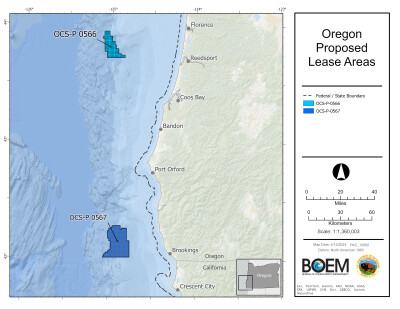The Interior Department moved ahead April 30 proposing the first offshore wind energy auctions in the Gulf of Maine and off Oregon, moving the Biden administration’s renewable energy drive into the realm of deeper waters and floating wind turbines.
The Gulf of Maine proposed sale would include eight lease areas off Maine, Massachusetts, and New Hampshire, covering nearly 1 million acres with potential for turbine arrays with a maximum rated output of 15 gigawatts, according to the federal Bureau of Ocean Energy Management.
(The actual average generation from wind turbines being built in the northwest Atlantic off the U.S. East Coast has been estimated at around 42% to 45% of maximum potential, often referred to as nameplate rating, according to industry sources and the U.S. National Renewable Energy Laroratory.)
BOEM narrowed the lease offering areas from its last wind energy area mapping in the gulf, a process the agency says “prioritized avoidance of offshore fishing grounds and identification of vessel transit routes, while retaining sufficient acreage to support the region’s offshore wind energy goals” of 13 GW to 18 GW.
The Oregon lease offerings are two areas: the Brookings Wind Energy Area of 133,792 acres, about 18 miles from shore, and the Coos Bay Wind Energy Area of 61,203 acres 32 miles offshore. Together the two areas could have potential for up to 3.1 GW of power output rating.
The move to lease areas for floating wind turbines is another level from BOEM leasing on the shallow East Coast outer continental shelf for turbines on foundations in the sea floor. The technology will have its own new issues with anchoring, cables and environmental impact.
Oregon tribes and commercial fishing groups pressed Gov. Tina Kotek trying to block BOEM leasing, and New England fishing advocates have been skeptical of the Gulf of Maine planning process.

BOEM Director Elizabeth Klein said the agency is continuing to work with interest groups: "As we move forward with offshore wind energy in Oregon and the Gulf of Maine, the Bureau of Ocean Energy Management remains dedicated to close collaboration with our government partners and key stakeholders."
BOEM worked with the National Oceanic and Atmospheric Administration’s National Centers for Coastal Ocean Science to use NOAA ocean resource information when analyzing wind energy areas. BOEM says the process “prioritized avoidance of offshore fishing grounds and identification of vessel transit routes, while retaining sufficient acreage to support the region’s offshore wind energy goals.”
In the Gulf of Maine, BOEM proposes simultaneous auctions for each of the eight lease areas using multiple-factor bidding. In the public comment period before the sales, is proposing bidding credits to wind companies that commit to supporting workforce training programs or supply chain development, or a combination of both, as well as a credit for a fisheries compensatory mitigation fund.
Other potential lease stipulations could focus on vessel transit and baseline environmental monitoring.
In Oregon, BOEM likewise proposes lease stipulations “to create good-paying union jobs and continue robust engagement with Tribal governments, the fishing industry, affected communities, and other ocean users. Potential stipulations for the proposed Oregon sale include providing bidding credits to bidders that commit to supporting workforce training programs for the floating offshore wind energy industry, developing a domestic supply chain for the floating offshore wind industry, or a combination of both.”
Wind companies could gain bidding credits with community benefit agreements with “Tribes, local communities, ocean users, or stakeholder groups expected to be affected by potential impacts from activities resulting from lease development,” according to BOEM.





